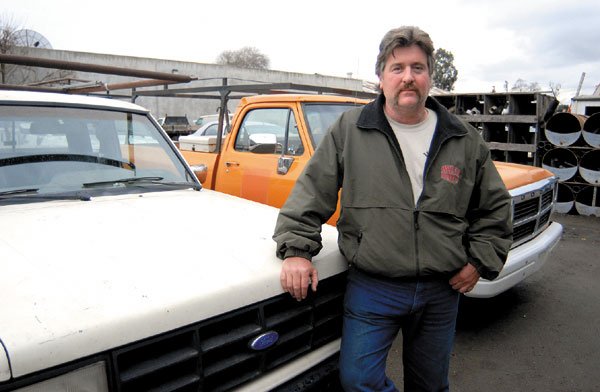Gilroy
– Crime is up in Gilroy. Just ask Jim Gorshe, a Gilroy plumber
who lost more than $200,000 to five different burglaries, from June
to January. Pricey copper pipes have vanished; a truck loaded with
tools disappeared, and turned up, stripped, off a Watsonville
highway.
Gilroy – Crime is up in Gilroy. Just ask Jim Gorshe, a Gilroy plumber who lost more than $200,000 to five different burglaries, from June to January. Pricey copper pipes have vanished; a truck loaded with tools disappeared, and turned up, stripped, off a Watsonville highway.
“I’m at my wits’ end,” said Gorshe, gesturing to the floodlights, security cameras and barbwire that ring his yard, off the busy corner of Leavesley and Monterey roads. “I can’t take it anymore.”
Or ask Cpl. Jim Callahan, who says Gilroy police are scrambling to keep up with the town’s staggering growth.
“We are just keeping our heads above the water,” said Callahan, vice-president of the Gilroy Police Officers’ Association. “Officers are being asked to allocate their time in several directions … it’s a difficult balancing act.”
Since 2002, burglaries have risen 50 percent; auto thefts are up 75 percent, mostly in the last year. Other crimes have risen slowly but surely over the past five years. Violent crimes and property crimes rose 28 percent since 2004, after dropping in 2002 and 2003. When counted with less serious FBI Part 2 crimes, such as DUI, fraud and forgery, the increases are more modest: a nearly 8 percent bump since 2002.
Arrests are up, too – but the arrest rate has dropped somewhat in the past year, from 79 to 74 arrests per 1,000. That’s no surprise to Asst. Chief Lanny Brown. Long before this year’s arrest rates were calculated, Brown guessed that arrests had taken a hit. In an unexpected baby boom, 11 officers took family medical leave last year, some for as long as 11 months. In a department of 61 officers, that’s bound to stretch the officers left behind.
“They spend so much of their time going from call to call,” Brown remarked, “that they have less and less time to be proactive.”
Staffing concerns
After scanning the stats, Callahan said, “the short answer is that we need more police officers.”
Years ago, City Council set a standard of 1.5 sworn officers per 1,000 Gilroy residents. With nearly 50,000 people and 61 sworn officers, Gilroy’s current rate is 1.2 officers per 1,000, or 14 officers short. Hiring all 14 would cost the city nearly $1 million per year, not including training and benefits.
“Our city has grown immensely, and the organization hasn’t kept pace with the growth,” said Sgt. John Sheedy. “If we added 14 more sworn positions, we could be much more proactive.” Sheedy cited increased traffic enforcement as an example. “But the issue here is budgets – there’s no doubt about that.”
Police chief Gregg Giusiana is waiting on the results of a $55,000 staffing study, approved by City Council in December, to see if consultants recommend more police on Gilroy streets. In the meantime, he said, he’s satisfied with staffing.
“The Council has done a very good job of supporting all departments in the city, including ours,” Giusiana said. Of course, “we could always use more officers – but then, the city could always use more planners, too.”
But frustration is percolating through the PD, where officers such as Callahan complain that they’re juggling emergency calls with traffic enforcement, gang crackdowns and school safety. If city bigwigs want to push forward with sprawling housing projects and massive new malls, they say, it’s time to expand police protection, too.
“Obviously, ‘more officers’ equates to ‘more money,’ and we all understand this,” Callahan said. “Still, there are only two options for the City Council: pony up the money, or dial down the growth.”
Wasting officer time?
Some officers gripe that report-writing is pulling police off the streets, and could factor into the crime increase.
A few years ago, officers switched from dictating reports, to be transcribed by records clerks, to typing them up themselves. Today, officers spend anywhere from 90 minutes to four hours each day, typing reports, said Callahan, averaging two hours a day.
“All agree that dictation was faster for the officers,” said Callahan, “and that typing reports requires them to spend more time in the office.”
Sheedy questioned whether the shift has upped crime.
“The officers aren’t on the street. They’re not visible,” Sheedy explained. “You want high-visibility patrols to deter crime … There are many factors for increased crime rates, and I think less visibility on the street is a factor.”
Administrators contend that the shift saves time for the department as a whole. When officers type their own reports, they complete them faster, and do them better, said Sgt. Kurt Svardal, public information officer.
“Report-writing takes time – period,” said Svardal. “Is it taking more officer time? Probably … But [dictation] takes more time for Records staff” – who are also under-staffed, Svardal noted. “In the past, our records unit was way behind. We had to get cases up to the District Attorney’s office on time.”
Poorly-written reports, he added, could land officers in court to clarify what they observed, and hobble the DA’s prosecutions.
“It’s a balance,” he concluded. “What’s best for everybody?”
Police haven’t addressed City Council about the issue, said Mayor Al Pinheiro. Nor has Giusiana or city administrator Jay Baksa raised it; Giusiana said it’s just “part of police work.”
But some of Gilroy decision-makers have already heard the beef about report-writing from fed-up cops – and some have sided with them.
“Why are we paying officers to sit there and type out a report?” asked City Council member Craig Gartman, in a December interview. “They’re trained to be out there in the field. Why don’t we bring in a typist who will sit down every evening, listen to the tapes and type the reports for the officers, who can proof them?”
Council member Russ Valiquette echoed his concerns.
“A police officer’s office is in the patrol car,” he said. “For every minute a police officer is in the station, that’s one less minute to deter someone from doing something.”
What the numbers mean
Chief Giusiana isn’t alarmed by the increase. Gilroy crime today is still short of crime levels in the mid-1990s, he said, “this stuff is cyclical.”
“It’s normal that as a city gets bigger, there’s more crime,” Giusiana said, “and crime is going to go up and down a little bit, no matter what. Number-wise, this isn’t a huge amount.”
Some numbers reflect regional trends, he added. Auto theft has spiked county-wide; the reason is unclear.
Mayor Pinheiro was similarly cautious, reviewing the stats.
“Let’s not just look at raw numbers and think that Gilroy is suddenly riddled with crime,” he said. Crime increases are “alarming, but we have the staff.” Neither Baksa nor Giusiana have approached him with “major concerns,” he said.
But some officers complain that Giusiana isn’t registering their complaints, let alone relaying them to the city’s top dogs. The unhappy numbers are bound to increase pressure on police administration to answer their questions – and those of City Council members, residents and aggravated business owners, such as Gorshe.
“The numbers overall don’t look good,” Valiquette said. “Questions have to be asked – and the administration has to give us some answers.”















